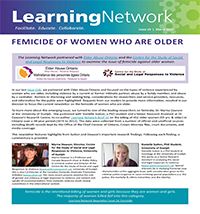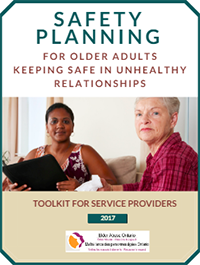Issue 19: Femicide of Women Who Are Older
 Printable PDF version
Printable PDF version
Plaintext PDF version
|
The Learning Network partnered with Elder Abuse Ontario and the Centre for the Study of Social and Legal Responses to Violence to examine the issue of femicide against older women.
|
In our last Issue (18), we partnered with Elder Abuse Ontario and focused on the types of violence experienced by women who are older, including violence by a current or former intimate partner, abuse by a family member, and abuse by a caretaker. Barriers to disclosing and seeking help, considerations for researchers and service providers, resources, and information for the public were highlighted. Requests from our readers to provide more information, resulted in our decision to focus the current newsletter on the femicide of women who are older.
To learn more about this emerging issue, we turned to one of the leading researchers on femicide, Dr. Myrna Dawson at the University of Guelph. She partnered with Danielle Sutton, a PhD student and a Senior Research Assistant at Dr. Dawson’s Research Centre, to co-author Learning Network Brief 31 on the killing of 452 older women (55 yrs. & older) in Ontario over a 38-year period (1974 to 2012). The data were collected from a number of official and unofficial sources including death records kept by the Office of the Chief Coroner of Ontario, Crown Attorney files, court documents, and media coverage.
This newsletter features highlights from Sutton and Dawson’s important research findings. Following each finding, a commentary is provided.
 Myrna Dawson, Director, Centre for the Study of Social and Legal Responses to Violence, University of Guelph Myrna Dawson is a Professor and Canada Research Chair in Public Policy in Criminal Justice and Director of the Centre for the Study of Social and Legal Responses to Violence (www.violenceresearch.ca), University of Guelph. She is also Co-Director of the Canadian Domestic Homicide Prevention Initiative (www.cdhpi.ca). Her most recent projects examine the role of gender and intimacy in legal responses to violence and content and uptake of recommendations from domestic violence death review committees in the international context.
Myrna Dawson, Director, Centre for the Study of Social and Legal Responses to Violence, University of Guelph Myrna Dawson is a Professor and Canada Research Chair in Public Policy in Criminal Justice and Director of the Centre for the Study of Social and Legal Responses to Violence (www.violenceresearch.ca), University of Guelph. She is also Co-Director of the Canadian Domestic Homicide Prevention Initiative (www.cdhpi.ca). Her most recent projects examine the role of gender and intimacy in legal responses to violence and content and uptake of recommendations from domestic violence death review committees in the international context.
Danielle Sutton, PhD Student, University of Guelph Danielle Sutton is a PhD student in Sociology at the University of Guelph. She works as a Senior Research Assistant in analyzing the social and legal responses to violence (www.violenceresearch.ca). Special interests lie in studying homicide case characteristics at the aggregate level, with consideration given to the criminal justice response in cases involving special populations (i.e. the police, the mentally ill, ethnic minorities, and the elderly).
Femicide is the intentional killing of women and girls because they are women and girls. The majority of women killed fall into this category.
Learning Network Newsletter Issue 14: Femicide
1 in 5 women murdered in Ontario from 1974 to 2012 was 55 years or older.
67% of older femicide victims were retired. This finding demonstrates the substantial number of older women in Ontario who were killed. While the killing of one woman is unacceptable, this statistic reminds us that gender-based violence exists across the life course and that intervention and prevention efforts must target all age groups, including women who are older. Moreover, the “baby boomers” are moving into this demographic and the number of women 55 years and older will represent a larger portion of the population in Ontario. This could mean that as this demographic ages, an even higher ratio of women killed will fall into this older category, having implications for risk assessment, risk management and safety planning.
The killing of older (93%) and younger (97%) women is overwhelmingly perpetrated by males.
The gendered nature of violence against women holds for femicide against women who are older. While early evidence suggests the nature of femicide against older women differs in some ways from femicide against younger women, prevention of femicide cannot be separated
from the broader context and root causes of violence against women (i.e. gender inequality, sexism, misogyny, power imbalances, institutionalized discrimination, and poverty).
“Femicide is the extreme end point on a continuum of violence against women. Femicide occurs because the continuum of violence against women continues to be accepted, tolerated and justified.”
Baker, L, Etherington, N, Pietsch, N. & Straatman, A.L. (2016)
67% of older femicide victims were retired.
The fact that older women are more likely to be retired may increase their isolation from both formal (services) and informal supports (friends, co-workers), which in turn, may increase their vulnerability and risk for being abused.
Older women were less likely than younger women to be killed by an intimate partner (38% vs. 67%). However, older women were more likely to be killed by another family member (25% vs. 8%) or a friend or an acquaintance (23% vs. 13%) than were younger women.
In our last Issue, we explained that women who are older can experience different forms of relational violence including abuse by a current or former intimate partner, abuse by a family member (e.g. child, sibling), and abuse by a caretaker (e.g. person who assists with caregiving). The above statistics demonstrate that any of the above abuse types can result in femicide. There is often overlap between the types of abuse experienced (e.g. intimate partner is also caregiver; family member is also caregiver). When overlap occurs, the context of each relationship must be considered in understanding the dynamics of the abuse being experienced; the meaning of the abuse to the woman; the risk factors that the abusive person brings to the situation (e.g. access to a weapon), and the vulnerabilities experienced by the woman experiencing violence (e.g. dependence on the abusive individual due to disability or financial situation). Service providers and the public need to be aware of the overlap and complexity of abuse for older women so that they know how to recognize it and what they can do if they suspect a woman is being abused (see Violence Against Women Who Are Older). This understanding is critical to informing comprehensive safety planning and risk management in the context of a variety of relationships where older women are abused (e.g. caregivers, friends, acquaintances and intimate partners).
Rita, age 57, was found in critical condition after being stabbed in her home in 2015. She later died in hospital. Her son, age 25, was charged with second-degree murder in connection with her death. Neighbours described Rita as a kind woman and a good mom who lived for her son.
Ontario Association of Interval & Transition Houses, Annual Femicide List November 25th, 2014 to November 24th 2015.
Women of all ages were at significantly less risk of femicide by strangers (10%).
Increased attention has been given to the impact (e.g. sadness, anxiety) of continual exposure to 24-hour news programs full of tragedies and dangers. As the social sphere of older individuals narrows, connections with the broader community are increasingly through television or social media and apprehensions about the dangers posed by strangers can be magnified.1
While we encourage reasonable safety precautions for all (e.g. locking doors, good lighting, social connections), service providers and the public need to be aware that abuse and femicide is most likely to be perpetrated against older women by intimate partners, family members, or friends/acquaintances.
In about half of the femicides of older women, there was evidence of prior violence by the perpetrator.
While almost three quarters of femicides of older women did not have previous police contact, there was evidence of prior threats in nearly one third of the cases and prior violence in about one half of these femicides. A history of violence is considered a risk factor for femicide, particularly in intimate partner relationships. This indicates that neighbours, friends, family, and social and health support workers need to be aware of warning signs and risk factors for abuse. A reluctance to contact police may change with time as social norms change.
| Older Women | Younger Women | |
| Prior Violence | 49% | 73% |
| Prior Threats | 32% | 53% |
| Prior contact with police | 27% | 47% |
Where a motivation was recorded in official records, the femicides of older women were attributed to mental illness, mercy killings, or suicide pacts.
A range of motives for femicide were reported by officials including quarrel, financial motivation, mental illness and jealousy. Jealousy is considered a significant risk factor for intimate partner femicide, and was found to be the most common motive for femicide of younger women. In contrast, the most frequently documented motive for the femicide of older women was mental illness, suspected mercy killings or suicide pacts. While these findings may be partially related to informant biases or recording practices, this early trend should be monitored and explored in future research. In the meantime, social support and mental health care providers need to be aware of the types of relational abuse and risk for femicide of older women when mental illness is a concern.
The topic of “mercy killings” is frequently raised in media discussions, most recently within the context of the pros and cons of “right to die” legislation. Often, examples involved older adults. For example, when a partner can no longer provide the extensive care required by their loved one. However, the wishes of the victim are not always known or clear.
Office of the Chief Coroner, Province of Ontario, Domestic Violence Death Review Committee 2015 Annual Report
Most commonly, older victims (29%) were beaten to death or subsequently died from complications that arose due to the beating (e.g. pneumonia). Moreover, 38% of these cases involved evidence of excessive force, or the use of multiple methods/repeated use of one method.
Regardless of the motive, we know that the majority of women did not experience a “merciful” method of death. Excessive force was used as frequently against older women as against younger women, and older women were more likely to die from being beaten or the subsequent complications.
Considerations for Moving Forward
Many of the tools used for threat assessment and safety planning within an intimate partner violence context relate more to the realities experienced by younger women as evidenced in Sutton and Dawson’s research findings. Threat assessment and safety planning tools should take into consideration the range of relationships (intimate partner, caregiver, family members) in which femicides of older women occur.
Older people’s fear of victimization and crime, and reluctance to reach out to police or other support agencies provide additional layers of complexity. Vulnerabilities such as the increased isolation of older women, and the potential risk posed by partners, family members or caregivers experiencing serious mental health problems, need to be considered and included in education and training for health and social service providers who work with older adults.
Additional research is needed to enhance our knowledge about the vulnerabilities and risks for different groups of women (e.g. older women with disabilities, persons who are transgender or gender diverse, racialized older women who are newcomers to Canada).
An intersectional understanding is essential for intervention and prevention of all violence against women, including its ultimate form— femicide. The need for such an approach is reinforced by the changing nature of migration patterns and the increasing diversity of Canadian communities. Constellations of intersecting vulnerability and risk are emerging as an important area for research. For instance, consider the structural and relational violence experienced by immigrant and refugee women experiencing housing insecurity as a result of leaving an abusive relationship.
In 2015, Ontario’s Domestic Violence Death Review Committee made a series of recommendations to prevent intimate partner homicides among older adults, including the “education of health care providers”, the “development of materials on structured risk assessment and management strategies”, and “extending public education campaigns to include domestic violence in the elderly population”
(see Domestic Violence Death Review Committee 2015 Annual Report).
Resources
 Safety Planning for Older Adults in Unhealthy Relationships
Safety Planning for Older Adults in Unhealthy Relationships
Some of the key components featured in the new toolkit include legal information for older adults in violent domestic relationships and practical strategies for developing a safety plan, as well as its integration into the response policies and protocols of agencies in the community. Elder Abuse Ontario will be launching this new toolkit soon. To learn more, please contact Elder Abuse Ontario.
It’s Not Right! Neighbours, Friends & Families for Older Adults Campaign
A collaboration of public education materials from leading prof essionals and advocates across Canada on the abuse and neglect of older adults. The It’s Not Right! campaign has developed several brochures for both the general public and older adults who are being abused, with information on safety plans, identifying abuse, and how to help older adults that are at risk. www.itsnotright.ca
 Senior Safety Line (SSL)
Senior Safety Line (SSL)
The SSL provides referral information for family members and health care providers for services across the province that can assist in cases of abuse of older adults.
1-866-299-1011
Research
Sutton, D. & Dawson, M. (January 2017). Femicide of Older Women. Learning Network Brief 31. London, Ontario: Learning Network, Centre for Research and Education on Violence Against Women and Children.
1Hayman, S. (2011). Older People in Canada: Their Victimization and Fear of Crime. Canadian Journal on Aging / La Revue canadienne du vieillissement 30(3), 423-436. Cambridge University Press. Retrieved March 1, 2017, from Project MUSE database.
Guest Reviewers:
Myrna Dawson, Ph.D., Director, Centre for the Study of Social and Legal Responses to Violence, University of Guelph
Danielle Sutton, Ph.D. Student, University of Guelph
Written by:
Linda Baker, Ph.D., Learning Director, Centre for Research & Education on Violence Against Women & Children
Anna-Lee Straatman, MLIS, Project Manager, Centre for Research & Education on Violence Against Women & Children
Graphic Design:
Elsa Barreto, Digital Media Specialist, Centre for Research & Education on Violence Against Women & Children
ISBN:
978-1-988412-04-7
Please evaluate us!
Let us know what you think. Your input is important to us. Please complete this brief survey on your thoughts of this newsletter.
Contact vawln@uwo.ca to join our email list!






